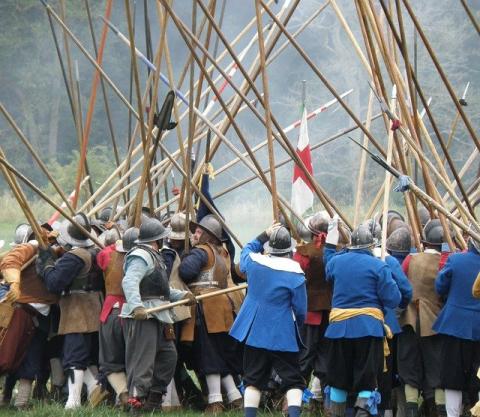Battle of Preston: Why it was Lost

Today marks the 370th anniversary of the Battle of Preston’s final day’s fighting. This is the battle to which Cromwell attended when he marched through Gisburn not far from our chapel. This battle has been called the most important of the Civil War; had Parliament lost it, Charles I would have been restored to the throne by the Scots.
The royalist side was made up of several armies, one commanded by Sir Mamaduke Langdale’s English and Irishmen, the other the Duke of Hamilton’s Scots. Here’s an extract from a letter of Langdale’s:
“…I was in at Settle and Gigleswick, with about 3000 foot and 600 Horse, the 13 of August, where hearing the Parliament forces were gathered together, and marching towards me, I went to acquaint Duke Hamilton therewith to Horneby, where he determined for Preston, where (his army being numerous in foot) he might have the greater advantage upon his enemy in those enclosed Countries. I Marched neere Clitherow towards Preston; in the March I met with the Lord Callender, and divers of the Scottish officers Quartered in my way, with whom I was resolved to march to Preston, but for the present the Intelligence was, that the Parliament Forces were divided, some part whereof were marched to Colne, and so to Manchester, to relieve that Towne in case we should presse upon it. This made the Officers of Horse more negligent of repayring to Preston, but Quartered wide in the Country. The same night certayne intelligence came that Lt. Generall Cromwell with all his Forces was within 3 miles of my Quarters, which I immediately sent to the Duke, and told it to my Lord Leviston to acquaint Lt. Generall Middleton therewith, and drew my Forces together in a field, and so marched towards Preston betimes in the morning…”
This is an interesting letter, not least because of the local place names it uses. The letter also includes reasons as to why the battle was lost:
- Intelligence was faulty. The Roundheads were not divided, with some in Colne and others in Manchester.
- The Royalist army was not only ill-informed but separated and spread out. The Duke of Hamilton was at Hornby. Lord Callendar was at Clitheroe. Sir Marmaduke was moving between Settle and Clitheroe, finding Scotsmen ‘in his way’.
Langdale continues:
Within halfe an hower of our meeting, and by that time I was drawen into the close neere Preston, the Enemy appeared with a small body of Horse; the Scotts continue their resolution for Wiggan, for which end they drew their Foote over the Bridge. The Enemy coming the same way that I had marched, fell upon my Quarter, where we continued skirmishing six houres, in all which time the Scott sent me no relief: they had very few horse come up, so as those they sent me at last were but few, and were soone beaten : but if they had sent me 1000 Foote to have flanked the Enemy, I doubt not the day had been ours. Yet I kept my post, with various successe, many times gathering ground of the Enemy ; and as the Scots acknowledg, they never saw any Foote fight better than mine did….”
- Despite engaging the Parliamentarians, the Scots do not come to Langdale’s aid, allowing him to bear the brunt and lose his army.
- This royalist army was not able to work together, one section of it sitting and watching another’s defeat.
As a Congregationalist and democrat, my sympathies are with Cromwell and the parliamentary army; their victory ensured a freedom for the gospel never previously enjoyed in the British Isles. Nevertheless, the Battle of Preston was a mass slaughter and a terrible burden on our area, with the troops of both sides expecting the local population to feed them, usually without payment.
And he shall judge among the nations, and shall rebuke many people: and they shall beat their swords into plowshares, and their spears into pruninghooks: nation shall not lift up sword against nation, neither shall they learn war any more.
-Isaiah 2:4
Source: An Impartial Relation of the Late Fight at Preston Being a Copy of a Letter by Sir Maramduke Langdale (1648)
Image by Sue Rickhuss from Pixabay
- Log in to post comments


 Sunday Worship 10.45am & 6.00pm
Sunday Worship 10.45am & 6.00pm